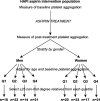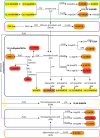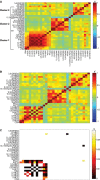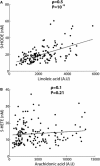Oxylipid Profile of Low-Dose Aspirin Exposure: A Pharmacometabolomics Study
- PMID: 26504148
- PMCID: PMC4845113
- DOI: 10.1161/JAHA.115.002203
Oxylipid Profile of Low-Dose Aspirin Exposure: A Pharmacometabolomics Study
Abstract
Background: While aspirin is a well-established and generally effective anti-platelet agent, considerable inter-individual variation in drug response exists, for which mechanisms are not completely understood. Metabolomics allows for extensive measurement of small molecules in biological samples, enabling detailed mapping of pathways involved in drug response.
Methods and results: We used a mass-spectrometry-based metabolomics platform to investigate the changes in the serum oxylipid metabolome induced by an aspirin intervention (14 days, 81 mg/day) in healthy subjects (n=156). We observed a global decrease in serum oxylipids in response to aspirin (25 metabolites decreased out of 30 measured) regardless of sex. This decrease was concomitant with a significant decrease in serum linoleic acid levels (-19%, P=1.3×10(-5)), one of the main precursors for oxylipid synthesis. Interestingly, several linoleic acid-derived oxylipids were not significantly associated with arachidonic-induced ex vivo platelet aggregation, a widely accepted marker of aspirin response, but were significantly correlated with platelet reactivity in response to collagen.
Conclusions: Together, these results suggest that linoleic acid-derived oxylipids may contribute to the non-COX1 mediated variability in response to aspirin. Pharmacometabolomics allowed for more comprehensive interrogation of mechanisms of action of low dose aspirin and of variation in aspirin response.
Keywords: aspirin; drugs; fatty acids; lipids; pharmacology; platelets.
© 2015 The Authors. Published on behalf of the American Heart Association, Inc., by Wiley Blackwell.
Figures




Similar articles
-
Purine pathway implicated in mechanism of resistance to aspirin therapy: pharmacometabolomics-informed pharmacogenomics.Clin Pharmacol Ther. 2013 Oct;94(4):525-32. doi: 10.1038/clpt.2013.119. Epub 2013 Jun 11. Clin Pharmacol Ther. 2013. PMID: 23839601 Free PMC article. Clinical Trial.
-
Orally given gastroprotective capsaicin does not modify aspirin-induced platelet aggregation in healthy male volunteers (human phase I examination).Acta Physiol Hung. 2014 Dec;101(4):429-37. doi: 10.1556/APhysiol.101.2014.4.4. Acta Physiol Hung. 2014. PMID: 25532954 Clinical Trial.
-
Platelet aggregation in response to collagen and thrombin reliably detects the ingestion of low-dose aspirin.Beitr Infusionsther Transfusionsmed. 1997;34:105-9. Beitr Infusionsther Transfusionsmed. 1997. PMID: 9356662
-
Advances in monitoring of aspirin therapy.Platelets. 2012;23(7):526-36. doi: 10.3109/09537104.2012.711865. Epub 2012 Aug 8. Platelets. 2012. PMID: 22873346 Review.
-
Antiplatelet effect of aspirin in patients with coronary artery disease.Dan Med J. 2012 Sep;59(9):B4506. Dan Med J. 2012. PMID: 22951204 Review.
Cited by
-
Plasma Metabolomics Analysis of Aspirin Treatment and Risk of Colorectal Adenomas.Cancer Prev Res (Phila). 2022 Aug 1;15(8):521-531. doi: 10.1158/1940-6207.CAPR-21-0555. Cancer Prev Res (Phila). 2022. PMID: 35653338 Free PMC article. Clinical Trial.
-
Chronic edible dosing of Δ9-tetrahydrocannabinol (THC) in nonhuman primates reduces systemic platelet activity and function.Am J Physiol Cell Physiol. 2022 Mar 1;322(3):C370-C381. doi: 10.1152/ajpcell.00373.2021. Epub 2022 Jan 26. Am J Physiol Cell Physiol. 2022. PMID: 35080922 Free PMC article.
-
Lipidomics in Understanding Pathophysiology and Pharmacologic Effects in Inflammatory Diseases: Considerations for Drug Development.Metabolites. 2022 Apr 7;12(4):333. doi: 10.3390/metabo12040333. Metabolites. 2022. PMID: 35448520 Free PMC article. Review.
-
Untargeted Metabolomics to Go beyond the Canonical Effect of Acetylsalicylic Acid.J Clin Med. 2019 Dec 24;9(1):51. doi: 10.3390/jcm9010051. J Clin Med. 2019. PMID: 31878351 Free PMC article.
-
Pioglitazone-induced alterations of purine metabolism in healthy male subjects.Clin Transl Sci. 2024 May;17(5):e13834. doi: 10.1111/cts.13834. Clin Transl Sci. 2024. PMID: 38771175 Free PMC article.
References
-
- Patrono C, Ciabattoni G, Patrignani P, Pugliese F, Filabozzi P, Catella F, Davì G, Forni L. Clinical pharmacology of platelet cyclooxygenase inhibition. Circulation. 1985;72:1177–1184. - PubMed
-
- Pedersen AK, FitzGerald GA. Dose‐related kinetics of aspirin. Presystemic acetylation of platelet cyclooxygenase. N Engl J Med. 1984;311:1206–1211. - PubMed
-
- Yerges‐Armstrong LM, Ellero‐Simatos S, Georgiades A, Zhu H, Lewis JP, Horenstein RB, Beitelshees AL, Dane A, Reijmers T, Hankemeier T, Fiehn O, Shuldiner AR, Kaddurah‐Daouk R. Purine pathway implicated in mechanism of resistance to aspirin therapy: pharmacometabolomics‐informed pharmacogenomics. Clin Pharmacol Ther. 2013;94:525–532. - PMC - PubMed
Publication types
MeSH terms
Substances
Grants and funding
- P30 NR014129/NR/NINR NIH HHS/United States
- U01 HL105198/HL/NHLBI NIH HHS/United States
- K23-HL091120/HL/NHLBI NIH HHS/United States
- P30-DK072488/DK/NIDDK NIH HHS/United States
- M01 RR002719/RR/NCRR NIH HHS/United States
- RC2GM092729/GM/NIGMS NIH HHS/United States
- P30 DK072488/DK/NIDDK NIH HHS/United States
- M01-RR-000052/RR/NCRR NIH HHS/United States
- K23-GM102678/GM/NIGMS NIH HHS/United States
- K23 GM102678/GM/NIGMS NIH HHS/United States
- M01-RR-16500/RR/NCRR NIH HHS/United States
- U01-HL72515/HL/NHLBI NIH HHS/United States
- K01-HL116770/HL/NHLBI NIH HHS/United States
LinkOut - more resources
Full Text Sources
Medical

